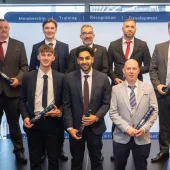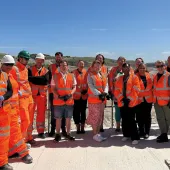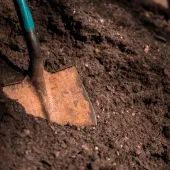Dredging Collaboration Delivers for Sibelco

First published in the October 2019 issue of Quarry Management
Project between Sibelco ad SE Davis shows how collaboration between two organizations can create a solution that is a potential game-changer for the sector
The UK’s quarrying and mineral products sector is always moving forward, seeking out new ways of doing things that challenge the status quo. These are often achieved through exciting collaborations between quarry operators and suppliers, introducing new innovations setting out standards of excellence that become future operational norms.
In its role as the professional membership body for the mineral products sector, the Institute of Quarrying (IQ) fulfils a pivotal role by sharing examples of good practice. James Thorne, IQ’s chief executive officer, explains: ‘Everything that we do at IQ is aimed at improving the standards of professionalism across our sector. We attempt to encapsulate this in our Skills Wheel, providing our members with an easily understandable framework for professional development.
‘The ‘Engagement, Influence and Impact’ Skills Wheel segment is about being more aware of how to interact as a professional with not just work colleagues, but everyone that you encounter as part of your role. There are many great examples of this that spring to mind, including a recent collaboration between one of our industry’s major international extractors and a smaller, more local contractor.’
Sibelco is a global material solutions company. The company’s UK operations have been producing world-renowned ball clay in the south-west of England for more than 300 years. Today, Sibelco is still a privately-owned family business, operating 195 production sites in more than 30 countries with a team of over 10,000 people.
Mike Davies is Sibelco UK’s regional operations manager, looking after seven of the company’s 10 UK quarries. One of the big challenges facing Sibelco is extending the operational life of its tailing lagoons. Mike explains: ‘On sites where we have large workable reserves and we are looking to extend operations, we often face the issue that existing tailing lagoons silt up.
‘When producing sand, any material below 90 microns in size is sent to waste. This ends up in our tailing lagoons, where it settles and when full, the lagoon is capped off and made safe. That’s an expensive process so we’re always looking at how we can extend the life of these lagoons. With shore-based long-reach ™
‘A further issue with long-reach excavators is the health and safety implications of operating large, heavy equipment close to open water. So, we set about trying to find a smart solution that took into account operator safety and environmental impact, with extending lagoon life.’
Remote-controlled dredging
Step forward SE Davis & Son Ltd. Based in Redditch, Worcestershire, they have built their reputation supplying mobile crushing, screening and washing equipment to the quarrying industry for more 35 years, as well as heavy plant and machinery and construction materials. Paul Davis is the fourth generation of the Davis family to work in the family-owned business. He was approached by Mike Davies at Sibelco and offered the opportunity to come up with a solution to extend the life of tailing lagoons for Sibleco.
Paul says: ‘I relish a challenge, and this was a big one. The traditional long-reach excavator route was a non-starter, as was the use of conventional dredging methods and technologies. That’s because the brief was about minimizing environmental impact, as well as maximizing operator safety.
‘We quickly recognized that a dredger was the way to clear the areas that a long-reach excavator couldn’t touch. But how do you remove an operator from a dredger? That’s where remote-control technology came to the fore. Then there was the question of environmental impact. On a conventional dredger there is fuel, grease and oil that potentially could spill into the lagoons. What we needed was a contaminant-free solution, so we looked at other technologies.
‘We designed and built from scratch a completely new dredger, one that’s remotely controlled by an operator from the safety of the shore. It’s powered umbilically from a shore-based supply. The dredger can excavate to depths of up to 5m and can pump silt from the lagoons over a kilometre away to be repurposed for other uses.’
James Thorne, IQ’s chief executive officer, says that the project between Sibelco and SE Davis shows how collaboration between two organizations can create a solution that is a potential game-changer for the sector. ‘Where possible, operators are looking to design out risk, using automated solutions. The example of Sibelco, working in partnership with SE Davis & Son Ltd, is a fantastic Skills Wheel case study. It shows how two businesses have put their heads together and created an innovative, remote-controlled dredger to clear silt lagoons.
‘In addition, the dredger has been designed to not pose an environmental risk by ensuring no contaminants are present. That’s brilliant and something that any business looking to prolong the operational life of its silt lagoons will welcome. In a sector that’s pushing the boundaries of environmental compliance and designing out risk, it doesn’t get much better than this.’
Mike Davies of Sibelco UK concludes: ‘Sibelco have worked with Paul and his team at SE Davis previously, so we knew what to expect from him. But he has really excelled. This is a solution that ticks every box for us and more. We are now able to extend lagoon life, which means decreased cost and better operational efficiencies at our UK quarries.’
For more information and to join IQ membership, visit: www.quarrying.org
- Subscribe to Quarry Management, the monthly journal for the mineral products industry, to read articles before they appear on Agg-Net.com








